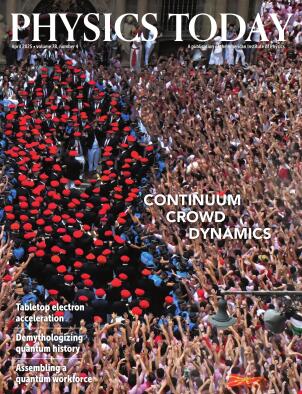Demythologizing quantum history
DOI: 10.1063/pt.assl.oxzd

Title pages from a selection of notable publications on or relating to quantum mechanics from the 1920s and 1930s. (Collage by Jason Keisling.)
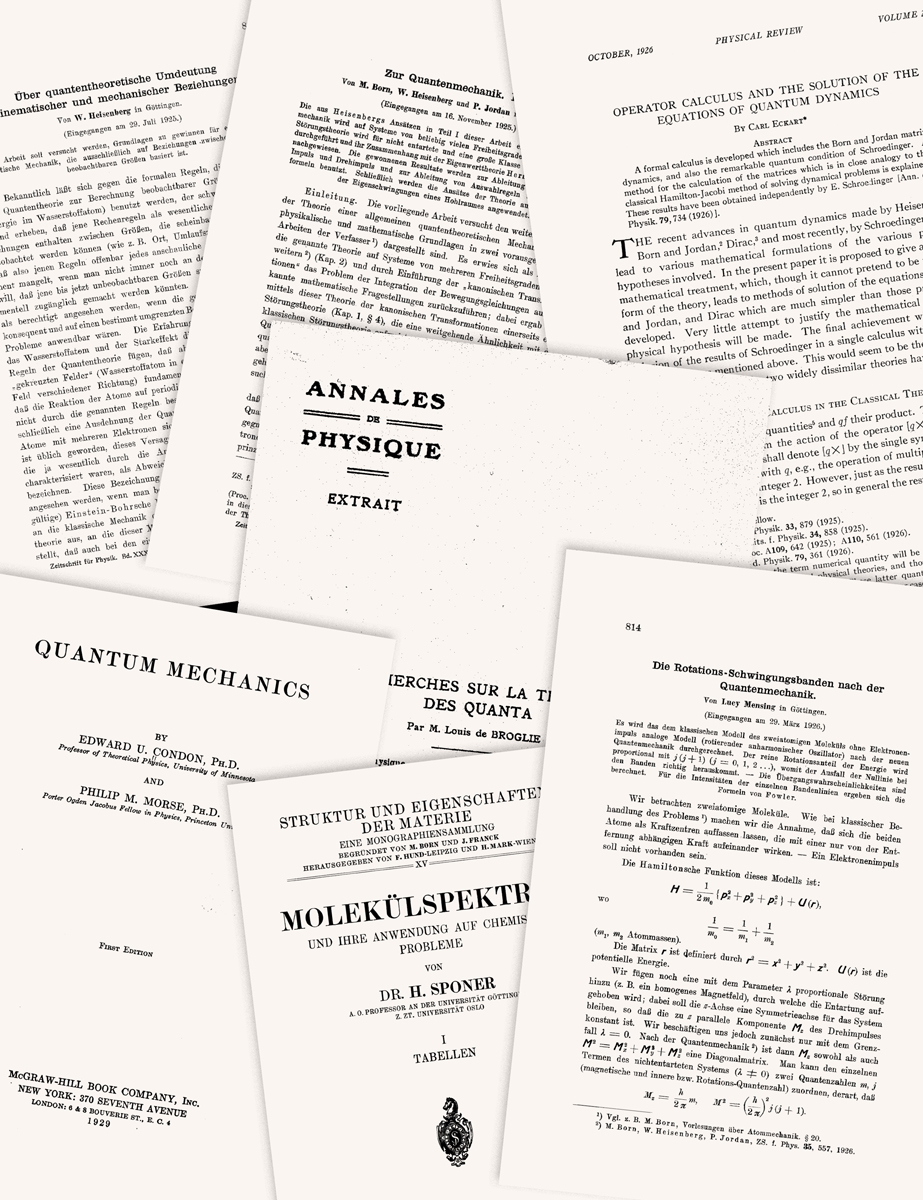
The United Nations has proclaimed this year the International Year of Quantum Science and Technology. Official pronouncements about the IYQ tend to emphasize forward-looking technological applications of quantum science, such as computing and cryptography. They nod only obliquely to the reason why 2025 was chosen as the IYQ: that this year is, allegedly, the centennial of the development of quantum mechanics. The UN resolution proclaiming the IYQ, for example, notes that 2025 “coincides” with the anniversary, and the official IYQ website mentions “100 years of quantum mechanics.”

But is 2025 really the 100th anniversary of quantum mechanics? It depends on whom you ask. According to the standard textbook narrative, it was in 1900 that Max Planck proposed the quantum hypothesis—that the magnitude of a physical property was not continuous but a set of discrete, countable units, or quanta. Several publications celebrated the 100th anniversary in 2000. 1 But Planck did not use the term “quantum” in 1900, and most historians now argue that he did not quantize anything that year. Other milestone years include 1905, when Albert Einstein introduced the quantum theory of light to explain the photoelectric effect, and 1913, when Niels Bohr debuted his solar-system model of the atom, in which electrons revolve around a nucleus in a set of discrete, quantized orbits.
That said, 1925 was, by any estimation, a pivotal year in the development of quantum mechanics. By that time, the deficiencies of what historians now term the old quantum theory were apparent. Based on Bohr’s atomic model, which was refined by Arnold Sommerfeld and others, the old theory could not accurately model the spectra of anything heavier than ionized helium. But 1925 marked the turning point toward the quantum mechanics we know today—a theory that remains part of the backbone of our understanding of the universe.
So it does make sense to celebrate this year. The trouble lies with the lack of clarity about what happened 100 years ago. Because most people aren’t familiar with the historical details, the IYQ threatens to fuel popular portrayals of Werner Heisenberg as the lone genius who initiated the quantum revolution. A closer examination of what happened in 1925 reveals that the development of quantum mechanics was a collaborative process from the start. It also serves as an example of how simplistic narratives of scientific discovery tend to perpetuate hero worship and omit other important contributors.
A satisfying story propagates
Despite efforts from historians to tell a nuanced story about the birth of modern quantum mechanics, the tale that’s seeped into the popular consciousness seems to stem from Heisenberg himself. As the German physicist related on several occasions, most notably in his 1969 memoirs, he had reached an impasse in his investigations of several problems in the old quantum theory in June 1925 when he was stricken by a bad bout of seasonal allergies. Seeking relief, Heisenberg decamped from his position at the University of Göttingen in Germany to the nearly pollenless island of Helgoland in the North Sea. Free from distractions and fortified by long walks and swims, Heisenberg devoted himself to his work attacking the inconsistencies in the old theory. One evening, he made the crucial breakthrough: Energy conservation had to hold true in his new quantum theory just as it did in classical physics. After working through the night carrying out calculations, he was quickly able to finish drafting a paper upon returning home.

Arnold Sommerfeld (left) and Niels Bohr (right) pictured in 1919. The two physicists were key contributors to the so-called old quantum theory, which assumed that electrons orbited a nucleus like a miniature solar system. (Photo from the AIP Emilio Segrè Visual Archives, Margrethe Bohr Collection.)
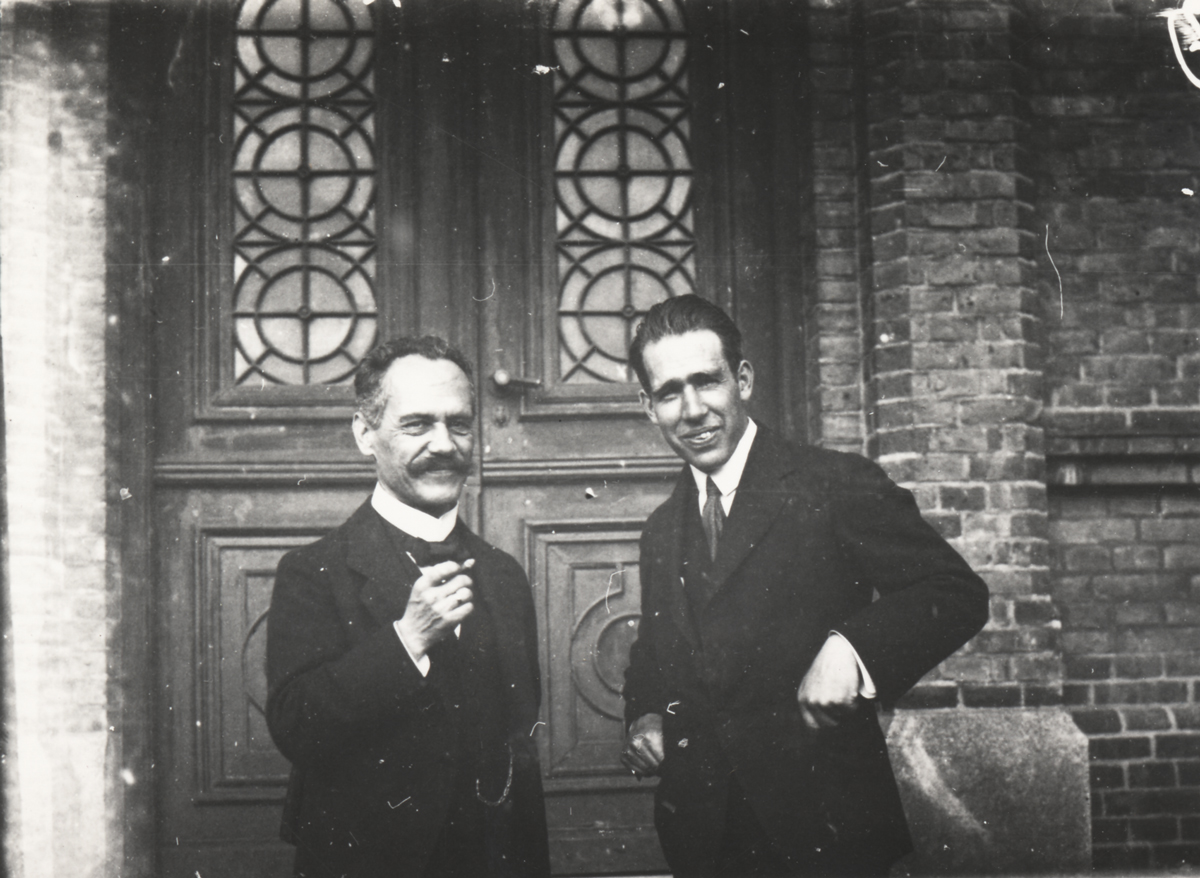
On 29 July, Heisenberg submitted his paper, 2 whose title translates as “On a quantum theoretical reinterpretation of kinematic and mechanical relations,” to the Zeitschrift für Physik, a relatively new German journal that had gained a reputation for publishing cutting-edge research. In the popular narrative, the Umdeutung (“reinterpretation”) paper, as it’s typically referred to after its original German title, birthed the matrix formulation of quantum mechanics and almost single-handedly initiated a dynamic period of feverish work that culminated in the creation of modern quantum theory in an astonishingly short amount of time. By 1927, it was mature enough that Bohr and Einstein were debating its philosophical implications at the Fifth Solvay Conference on Physics. And a few years later, Heisenberg would receive the 1932 Nobel Prize in Physics “for the creation of quantum mechanics.”
It’s not surprising that Heisenberg’s narrative took off. After all, what could be more poetic than a sensitive, Nobel-winning savant who, paralyzed by mere allergies, sought refuge on a remote, beautiful island, where he had a stroke of genius? The Helgoland story now permeates popular writing on the quantum revolution of the 1920s. “If there is any moment that marks the birth of quantum mechanics,” wrote Steven Weinberg in 1994, “it would be a vacation taken by the young Werner Heisenberg in 1925. . . . On Helgoland [he] made a fresh start.” 3
Inadvertently or advertently, the IYQ organizers are contributing to the Heisenberg hagiography: One of the most prominent meetings will be held on Helgoland this June. The workshop features many distinguished members of the field, including 2022 Nobel laureates Alain Aspect, John Clauser, and Anton Zeilinger, and focuses on the future of quantum science and technology. But its website perpetuates the heroic version of quantum history by asserting that Heisenberg “developed Matrix Mechanics, the first formulation of Quantum Theory” during his 1925 trip to the island.
The Helgoland myth
The veracity of the Helgoland story is dubious at best. It has its roots in Heisenberg’s memoirs, Der Teil und das Ganze, which were published in English in 1971 under the title of Physics and Beyond. But memory is notoriously unreliable. Heisenberg admitted in the book’s preface that it wasn’t a “historically accurate retelling of all the various events in every detail” and that he only intended to depict the “broader picture.” 4 Far too many writers have taken his account as gospel.

The Lummenfelsen cliffs on the German island of Helgoland in the North Sea. Werner Heisenberg spent about 10 days on the island during an oft-mythologized visit in June 1925, during which he allegedly made a breakthrough in the development of the matrix formulation of quantum mechanics. (Photo by BraunGregor, Wikimedia Commons/CC BY 4.0
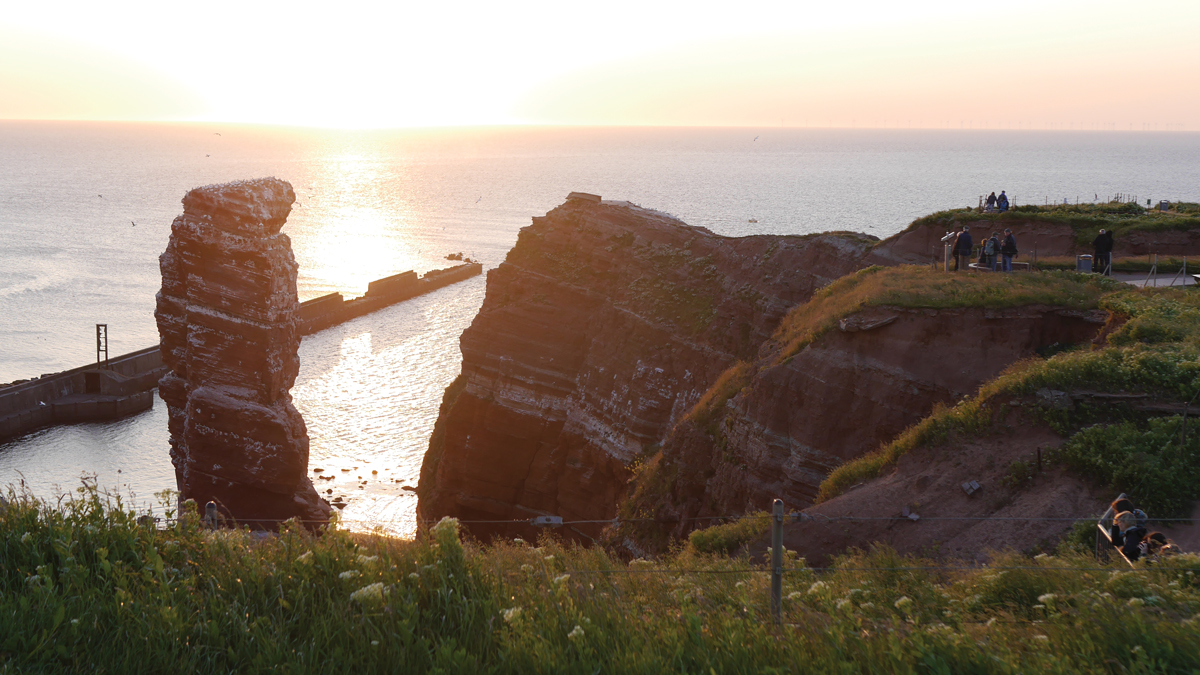
Contemporary evidence confirms that Heisenberg spent about 10 days on Helgoland in June 1925. It’s not clear how much he accomplished there: As Anthony Duncan and Michel Janssen note in their magisterial history of the 1920s quantum revolution, Heisenberg probably did much of the work on the Umdeutung paper before and after his brief visit to Helgoland. 5 Moreover, as they point out, several letters he wrote to Wolfgang Pauli in June and July of that year indicate that Heisenberg was not confident in his theory at first. He was so unsure of his results that he gave his finished manuscript to Max Born, who supervised his 1924 habilitation at the University of Göttingen, to look over and decide whether it was worth submitting. That’s not exactly what you’d expect from someone who allegedly had a eureka moment.
Moreover, the Umdeutung paper is notoriously obscure. In the same book in which he propagated the Helgoland myth, Weinberg went on to confess that he had “never understood Heisenberg’s motivations for the mathematical steps in his paper” and that he believed the article to be “pure magic.” 6 He is not the only one who has been baffled by the Umdeutung paper over the years: Something of a cottage industry among technically oriented historians of physics has developed that attempts to explain both the content of the paper and its intellectual backstory. Tellingly, the various exegeses of the Umdeutung paper invariably dwarf the slender 15-page original: An early and widely cited 1977 article on the topic by historian and philosopher Edward MacKinnon, for example, runs to 52 pages, while Duncan and Janssen devote an entire 46-page chapter of their 2023 book to it. 7
It was only after other researchers recognized that Heisenberg’s clunky calculations could be elegantly rewritten using the mathematical language of matrices—a formalism unknown at the time to nearly all physicists, including Heisenberg—that his work began to assume the form in which it is taught today. Born was immediately captivated on reading Heisenberg’s Umdeutung paper, and he soon roped the mathematically talented Pascual Jordan—one of his former doctoral students—into a collaboration. They submitted their paper on the topic, whose title translates as “On quantum mechanics,” to the Zeitschrift für Physik on 27 September 1925. It was only in that article that matrix mechanics started to resemble something that today’s physicists are likely to understand. 8
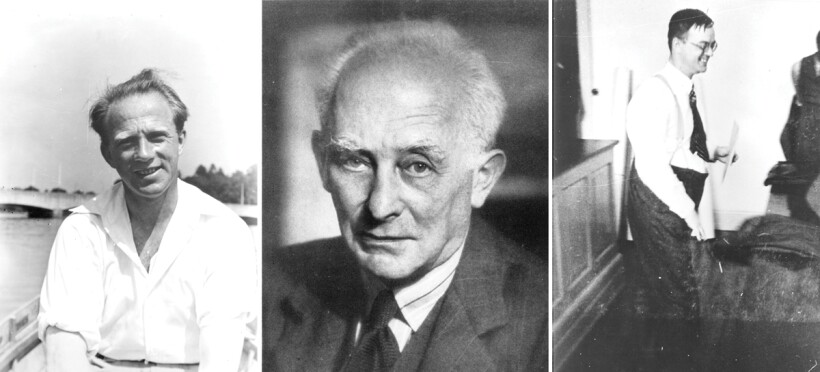
Werner Heisenberg, Max Born, and Pascual Jordan (from left to right). Although Heisenberg typically receives the lion’s share of the credit for the development of the matrix formulation of quantum mechanics in late 1925, Born’s and Jordan’s contributions were equally pivotal. With their mathematical backgrounds, the two realized that Heisenberg’s clunky equations could be elegantly rewritten using the mathematical language of matrices. (Photo of Heisenberg from the Max Planck Institute, courtesy of the AIP Emilio Segrè Visual Archives; photo of Born from the AIP Emilio Segrè Visual Archives, gift of Maria Goeppert Mayer; photo of Jordan from the Niels Bohr Archive, B526, Copenhagen, courtesy of the AIP Emilo Segrè Visual Archives.)
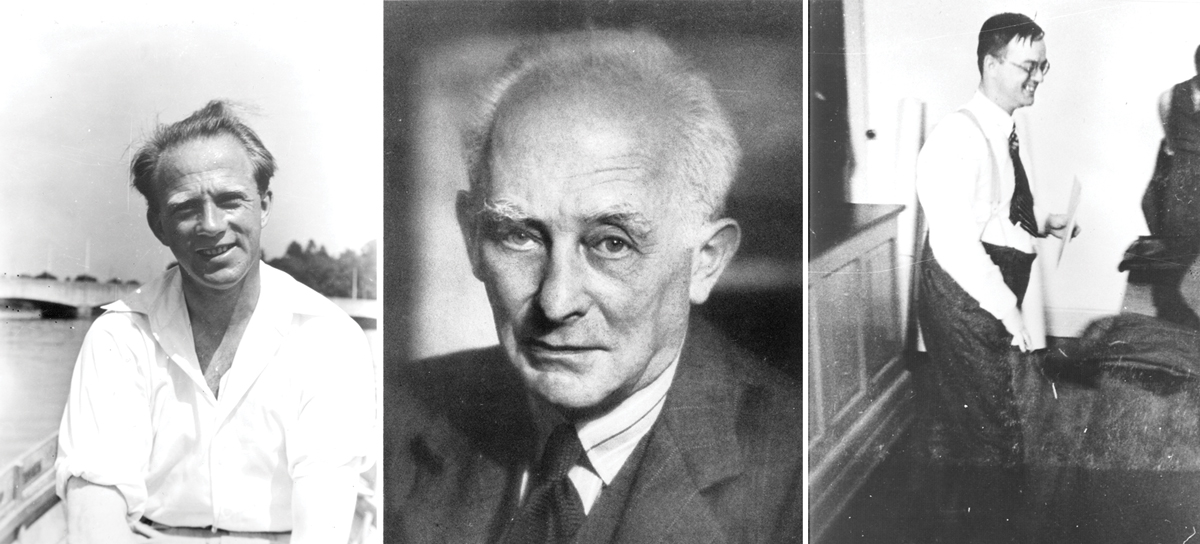
Even before finalizing the paper, Born and Jordan began collaborating with Heisenberg on a follow-up article that was submitted to the Zeitschrift für Physik on 16 November that same year. 9 Often referred to as the “three-man paper,” it was arguably the most crucial milestone of that year: Historian of science Max Jammer termed it the “first comprehensive exposition of the foundations of modern quantum mechanics in its matrix formulation.” 10 Heisenberg admitted that the Royal Swedish Academy of Sciences should have split the 1932 Nobel Prize: After receiving the news about the award, he wrote separately to Born and Jordan stating that he was sorry the three had not shared it. 11
An important lesson
Although textbooks and popular articles alike continue to repeat the Helgoland myth and perpetuate hero worship, the real story of the genesis of matrix mechanics in 1925 was one of collaboration and teamwork between Heisenberg, Born, Jordan, and even Pauli. That lesson holds true for the history of quantum mechanics writ large. Historians estimate that between 1925 and 1927, almost 200 papers were published—many of which were authored by long-forgotten individuals—that advanced the new theory and applied it to various problems in atomic dynamics.
One prominent example is US physicist Carl Eckart, who asserted the equivalence of the matrix and wave formulations of quantum mechanics independently of Erwin Schrödinger. Working in California, Eckart submitted his paper in June 1926 to a then-obscure journal called Physical Review, some three months after Schrödinger sent off his famous equivalency paper to the Annalen der Physik in Germany. Although Eckart did not receive priority for the discovery—in a note added on 2 September, when the article went to press, he lamented that Schrödinger had already “published all the essential results contained in the above paper” 12 —his contribution was nevertheless important. Eckart used matrix mechanics as his starting point and then attempted to demonstrate its equivalence to the wave formulation; Schrödinger’s proof worked the other way around. Ironically, most scholars now agree that both Eckart and Schrödinger’s proofs were incomplete and that it was actually John von Neumann, building on their and others’ work, who conclusively showed in a series of publications in the late 1920s and early 1930s that the two formulations were equivalent. 13

Carl Eckart, Lucy Mensing, and Hertha Sponer are among the early contributors to quantum mechanics whose names do not usually appear in physics textbooks. Eckart (portrait at left) asserted the equivalence of the matrix and wave formulations of quantum mechanics in 1926 independently of Erwin Schrödinger. That same year, Mensing (third from left in the middle photo) was one of the first to apply the new quantum theory to diatomic molecules. Sponer (photo at right) conducted early spectroscopic work in the 1920s and 1930s that experimentally confirmed the predictions of quantum mechanics. (Photo of Eckart from the AIP Emilio Segrè Visual Archives; photo of Mensing from the AIP Emilio Segrè Visual Archives, Landé Collection; photo of Sponer from the AIP Emilio Segrè Visual Archives, Lisa Lisco, gift of Jost Lemmerich.)

Lucy Mensing, who was working in Göttingen when Heisenberg, Born, and Jordan made their breakthrough in 1925, quickly became acquainted with the new quantum mechanics and may have been the first individual to apply the theory to diatomic molecules. 14 Mensing followed up her pathbreaking article by collaborating with Pauli—who had supervised her dissertation in Hamburg—on presenting a quantum understanding of the electric polarizability of those molecules. Physicist Gernot Münster terms the article a “milestone in applied quantum mechanics.” 15 Although little primary documentation about her career survives, Mensing seems to have gradually withdrawn from the field in the late 1920s in part because she was put off by the highly competitive academic culture of the era. Her last scientific publication appeared in 1930, although she apparently continued to assist her husband, fellow physicist Wilhelm Schütz, with his work afterward. 16
Another physicist working in Göttingen during the quantum revolution of the mid 1920s was Hertha Sponer. She went on to publish a number of works, including an influential two-volume set on spectroscopy in 1935–36 that experimentally confirmed predictions of quantum mechanics. 17 Unlike Mensing, Sponer remained in academia for the long haul. As a woman in Nazi-ruled Germany, she had little hope of obtaining an academic position, so she ended up emigrating, first to Norway in 1934 and then in 1936 to the US, where she received a tenured position at Duke University. 18
Eckart, Mensing, and Sponer are just the tip of the iceberg: There are many other early quantum innovators who aren’t part of the standard canon. If we’re going to recognize the 100th anniversary of quantum mechanics this year, let’s broaden the scope of our celebration. Despite their vague rhetoric about what happened in 1925, even the IYQ organizers seem to be cognizant of the dangers of hagiography: In their mission statement, they urge participants to “foreground honesty about the past and future of quantum science and technology.” At the very least, let’s avoid the type of hero worship emblematized by the Helgoland myth.
This article was originally published online on 21 March 2025.
Thanks to Michel Janssen for providing helpful comments that prevented the inadvertent propagation of several quantum myths.
References
1. See, for example, A. Zeilinger, Nature 408, 639 (2000);https://doi.org/10.1038/35047177
D. Kleppner, R. Jackiw, Science 289, 893 (2000);https://doi.org/10.1126/science.289.5481.893
D. Overbye, New York Times, 12 December 2000, p. F1. Read online2. W. Heisenberg, Z. Phys. 33, 879 (1925).https://doi.org/10.1007/BF01328377
3. S. Weinberg, Dreams of a Final Theory, Vintage Books (1994), p. 66.
4. W. Heisenberg, Der Teil und das Ganze: Gespräche im Umkreis der Atomphysik (Physics and Beyond: Encounters and Conversations), Piper (1969), p. 7. All translations from German are my own.
5. A. Duncan, M. Janssen, Constructing Quantum Mechanics, Volume 2: The Arch, 1923–1927, Oxford U. Press (2023), p. 224.
6. Ref. 3, p. 67.
7. E. MacKinnon, Hist. Stud. Phys. Sci. 8, 137 (1977);https://doi.org/10.2307/27757370
ref. 5, p. 209.8. M. Born, P. Jordan, Z. Phys. 34, 858 (1925).https://doi.org/10.1007/BF01328531
9. M. Born, W. Heisenberg, P. Jordan, Z. Phys. 35, 557 (1926).https://doi.org/10.1007/BF01379806
10. M. Jammer, The Conceptual Development of Quantum Mechanics, 2nd ed., Tomash (1989), p. 221.
11. W. Heisenberg to M. Born, 25 November 1933, file 1/3/2/4, The Papers of Professor Max Born, Churchill Archives Centre, U. Cambridge;
P. Jordan to W. Heisenberg, 6 June 1934, file 1515/2, Werner Heisenberg Papers, Archives of the Max Planck Society, Berlin.12. C. Eckart, Phys. Rev. 28, 711 (1926), p. 726.https://doi.org/10.1103/PhysRev.28.711
13. Ref. 5, p. 642;
F. A. Muller, Stud. Hist. Philos. Mod. Phys. 28, 35 (1997);https://doi.org/10.1016/S1355-2198(96)00022-6
F. A. Muller, Stud. Hist. Philos. Mod. Phys. 28, 219 (1997);https://doi.org/10.1016/S1355-2198(97)00001-4
F. A. Muller, Stud. Hist. Philos. Mod. Phys. 30, 543 (1999).https://doi.org/10.1016/S1355-2198(99)00016-714. L. Mensing, Z. Phys. 36, 814 (1926).https://doi.org/10.1007/BF01400216
15. L. Mensing, W. Pauli, Phys. Z. 27, 509 (1926);
G. Münster, Phys. J. 19(6), 30 (2020), p. 33.16. G. Münster, M. Janssen, in Women in the History of Quantum Physics: Beyond Knabenphysik, P. Charbonneau et al., eds., Cambridge Press (in press).
17. H. Sponer, Molekülspektren und ihre Anwendung auf chemische Probleme (Molecular spectra and their application to problems in chemistry), two vols., Springer (1935–36).
18. E. Crull, in ref. 16.
More about the Authors
Ryan Dahn is a senior associate editor at Physics Today and a historian of science.
Ryan Dahn. rdahn@aip.org

